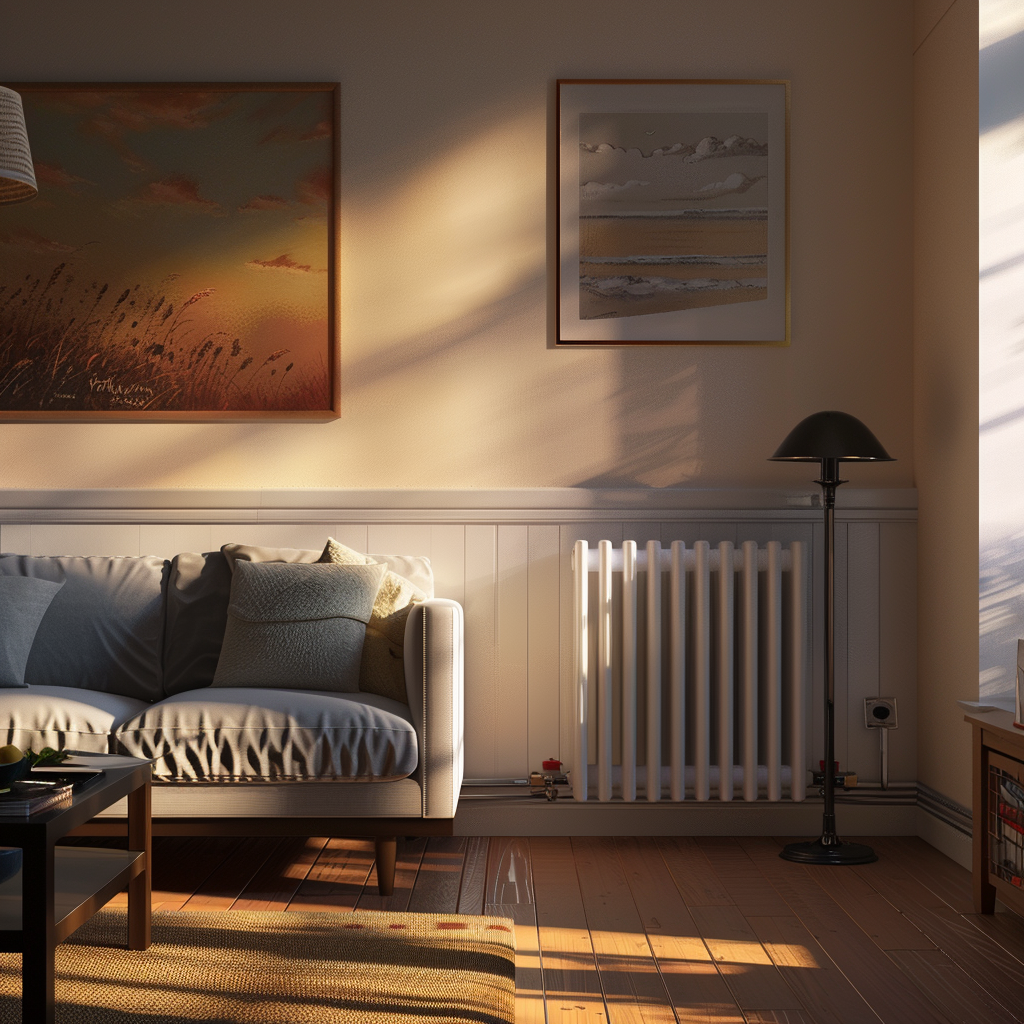How to Bleed a Radiator: Easy Step-by-Step Guide for Optimal Home Heating

Share
Radiators are a common feature in many homes, particularly in older buildings or those with a central heating system. They are crucial for providing consistent heat throughout the house, especially during the colder months. This guide will explain everything you need to know about radiators, including what they are, how they work, and how to maintain them by bleeding them.
What is a Radiator?
A radiator is a heat exchange device used to transfer thermal energy from one medium to another for the purpose of space heating. In homes, radiators are typically part of a central heating system that heats water, which is then circulated through a network of pipes to radiators located in different rooms.
Radiators come in various types:
- Panel Radiators: Common in modern homes, they are flat and mounted on walls.
- Column Radiators: Often found in older homes, they have a vintage look with vertical columns.
- Towel Radiators: Typically used in bathrooms to warm towels.
- Baseboard Radiators: Long and low, installed along the baseboards of walls.
How Radiators Work
Radiators work by circulating hot water or steam from a boiler through a network of pipes to the radiators in different rooms. The hot water heats the metal surface of the radiator, which then radiates heat into the room. As the water cools, it returns to the boiler to be reheated and recirculated.
Why Bleed a Radiator?
Over time, air can become trapped in the radiator, preventing the hot water from circulating properly. This trapped air can cause cold spots on the radiator, reducing its efficiency. Bleeding the radiator releases this trapped air, allowing the hot water to fill the entire radiator and provide consistent heat.
Tools and Supplies You’ll Need
Before you begin, gather the following tools and supplies:
- Radiator bleed key (or a flat-head screwdriver for some modern radiators)
- A small bowl or cloth to catch any water
- Towels to protect your flooring
Step-by-Step Guide to Bleeding a Radiator
-
Turn Off Your Heating System: Before bleeding your radiators, ensure your heating system is turned off and the radiators are cool. This will prevent hot water from spraying out and causing burns.
Personal Tip: Always let the radiators cool completely before starting. This ensures safety and avoids hot water accidents. -
Locate the Bleed Valve: Find the bleed valve on your radiator. It is usually located at the top corner of the radiator. The bleed valve looks like a small, round hole with a square or slotted screw in the center.
-
Insert the Radiator Key: Place the radiator bleed key over the bleed valve. If your radiator uses a screwdriver, insert the flat-head screwdriver into the valve slot.
Personal Tip: Keep a cloth or small bowl handy to catch any drips of water. -
Open the Valve: Slowly turn the key or screwdriver counterclockwise. You will hear a hissing sound as the trapped air escapes. Hold the bowl or cloth under the valve to catch any drips of water.
Personal Tip: Turn the key gently; there’s no need to force it. Stop once water starts to flow steadily. -
Close the Valve: Once water starts to escape steadily from the valve, turn the key or screwdriver clockwise to close the valve. Be sure not to over-tighten it.
-
Check the Pressure: After bleeding the radiators, check the pressure gauge on your boiler. If the pressure is too low, you may need to top up the system with water. Consult your boiler’s manual for instructions on how to do this.
-
Turn Your Heating System Back On: Turn your heating system back on and check the radiators. They should now be heating evenly from top to bottom.
Common Issues and Solutions
While bleeding radiators is generally straightforward, you might encounter a few issues:
-
No Air Escapes: If no air escapes when you open the bleed valve, the problem might not be air-related. It could be a blockage or a more serious issue that requires a professional.
Personal Tip: If no air or water escapes, consider consulting a professional as it may indicate a different problem. -
Water Pressure Drops: After bleeding, if the water pressure drops significantly, you might need to repressurize your heating system. Follow your boiler’s manual for guidance.
-
Persistent Cold Spots: If cold spots persist even after bleeding, it might indicate sludge buildup inside the radiator. This typically requires a professional power-flushing service.
Preventative Measures
To keep your radiators working efficiently:
-
Regular Maintenance: Bleed your radiators at least once a year, preferably before the start of the heating season.
Personal Tip: Set a yearly reminder to bleed radiators as part of your home maintenance routine. -
System Checks: Regularly check the pressure in your heating system and top it up if necessary.
-
Professional Servicing: Have your boiler and heating system serviced annually by a qualified professional.
When to Call a Professional
While bleeding radiators is a simple DIY task, there are times when you might need to call a professional:
-
Persistent Cold Spots: If your radiators still have cold spots after bleeding, there may be a more serious issue.
Personal Tip: Don’t hesitate to call a professional if you’re unsure. Better safe than sorry. -
Multiple Radiators Not Heating: If several radiators are not heating properly, it could indicate a problem with your central heating system.
-
Low System Pressure: If you cannot maintain the correct pressure in your heating system, a professional may need to inspect your boiler and heating system for leaks or other issues.
Environmental and Financial Benefits
Properly maintaining your radiators by bleeding them regularly can lead to significant benefits:
-
Energy Efficiency: Radiators that heat evenly require less energy to maintain a comfortable temperature in your home, reducing your carbon footprint.
-
Cost Savings: Improved efficiency translates to lower energy bills, saving you money in the long run.
-
Extended System Life: Regular maintenance helps prevent wear and tear, extending the lifespan of your heating system and reducing the need for costly repairs or replacements.
Tips for Prolonging the Life of Your Radiators
-
Regular Cleaning: Dust and debris can accumulate on radiators, reducing their efficiency. Regularly clean the surface and fins of your radiators to ensure optimal heat distribution.
-
Insulate Pipes: Insulating the pipes that lead to and from your radiators can help maintain water temperature, improving the efficiency of your heating system.
-
Balance Your Radiators: Ensure all radiators heat up at the same rate by balancing them. This involves adjusting the valves to control the flow of water through each radiator.
Additional Maintenance Tips
-
Radiator Covers and Reflectors: Use radiator covers and reflective panels behind radiators to improve efficiency. Reflectors help direct more heat into the room, rather than being absorbed by the walls.
-
Check for Leaks: Regularly inspect your radiators and pipes for any signs of leaks. Early detection can prevent more significant issues and costly repairs.
-
System Flushing: Periodically flush your heating system to remove sludge and debris. This helps maintain the efficiency and longevity of your radiators and boiler.
-
Thermostatic Radiator Valves (TRVs): Consider installing TRVs on your radiators. These valves allow you to control the temperature of individual rooms, improving overall heating efficiency and comfort.
Frequently Asked Questions
-
How often should I bleed my radiators? You should bleed your radiators at least once a year, preferably before the start of the heating season. If you notice cold spots or hear gurgling sounds, it may be time to bleed them more frequently.
-
What if my radiator is still cold after bleeding? If your radiator remains cold after bleeding, there may be a more serious issue, such as a blockage or a problem with the central heating system. It’s best to call a professional for a thorough inspection.
-
Can I bleed my radiators while the heating is on? It’s important to turn off your heating system and let the radiators cool before bleeding them. This prevents hot water from spraying out and causing burns.
-
What should I do if I don’t have a radiator key? If you don’t have a radiator key, you can purchase one at most hardware stores. Some modern radiators can be bled using a flat-head screwdriver.
-
Why is my radiator making noise? Noises such as banging, gurgling, or whistling can indicate trapped air, sludge buildup, or other issues within the heating system. Bleeding the radiators often resolves these problems, but persistent noise may require professional attention.
Bleeding your radiators is a simple, yet essential, task for maintaining an efficient and effective home heating system. By following this step-by-step guide, you can ensure your radiators are working at their best, providing consistent warmth throughout your home. Regular maintenance and mindful usage can help prevent future issues, ensuring your heating system remains in top condition. If you encounter persistent problems, don’t hesitate to call a professional for assistance.
Proper radiator maintenance not only keeps your home warm but also helps you save money on energy bills and reduce your environmental impact. Regularly cleaning, checking for leaks, and balancing your radiator will help keep them running smoothly for years to come.


